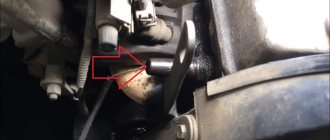“Gluttony” LADA Vesta
A trip on vacation along the Arkhangelsk-Yeysk route and back, as well as using a car to travel on vacation “turned out” to 6,000 km of mileage and increased fuel consumption:
“On the highway at an average speed of 80 km/h without air conditioning 7.3 liters, with air conditioning 7.8 liters. In the city, the average speed is 19 km/h, with air conditioning 13 l. This is too much for a 1.6 engine,” notes the owner.
The 1.8-liter Vesta has an even higher appetite, so a trip to the sea under its own power can cost a pretty penny.
Our “blonde” Lada Vesta continues to be used daily in Siberia, on Lake Baikal. Over the past month and a half since the previous publication, 5,000 km have been added to the odometer. One of the most notable events was a trip to the northeast of Baikal and TO-2, during which we inspected a VAZ service in Ulan-Ude.
Any road is dear to us
A trip to the Trans-Baikal National Park and the Barguzin Valley became the first test for Vesta as... an all-terrain vehicle. And what? Yes, everything is fine! Not every passenger car will pass here, but Vesta passed without any difficulties. The 17-centimeter ground clearance is quite enough for light off-roading, even though the car was fully loaded with belongings for life in the field, and the crew consisted of three full-sized men - the driver was accompanied by young scientists from the Institute of Geography.
The total mileage on this expedition was 2000 km, of which a good third were dusty sandy forest roads, mountain paths with protruding massive boulders and long gravel roads with large stones.
Constant shaking on a corrugated path, clouds of dust from oncoming and passing cars are specific conditions in which it is revealed how ready this modern car is for use in the Russian outback, where established archaic solutions are more preferred. Ready! Dust may be sucked into the interior when driving on gravel roads, but to a minimum, the car handles different-sized surfaces confidently. Yes, the suspension is not the quietest, and the dashboard is not too silent, but knocks and squeaks are not critical or intrusive. High ground clearance allows you to carefully overcome boulders protruding on a mountain road. With preliminary reconnaissance, we were able to drive along the sand - for an overnight stay on the sandy beach of Myagkaya Karga.
The average fuel consumption on this trip was 7 liters per 100 km (but the movement was calm) - quite decent. The only negative nuance in such poor road use is the standard low-profile tires, which are not the most suitable option for Siberian gravel roads with large stones. As a result, the rear wheel was punctured once, leaving us far from civilization without a spare wheel.
As a result, today there are more than 33 thousand kilometers on the odometer, not a break-in mileage at all, and the car, designed in Russia, for Russia, assembled in Russia, does not break down! In any other case, this would be a serious reason for joy and a pleasant shock, especially for those who risked investing their hard-earned money in a revolutionary product of the domestic automobile industry. But for a blog this is a failure - there is absolutely nothing to write about! On the other hand, such information hunger forces us to sniff out any, even subtle, odor of unfinished work in our domestic Vesta. And you know - yours really doesn’t smell! At least you don't have to turn your nose up.
The more I ride Vesta, the more convinced I become that its element is the highway, the average Russian federal highway. In the USA, on their highways, a special corrugation is made on the sides so that a tired driver, if he suddenly loses his course, can wake up from the vibrations. In our country, even taking into account the genetically resilient cerebellum of drivers, it is not easy to fall asleep on a federal highway. And I still don’t want to drive Vesta. It is in the city that its elastic suspension causes the entire contents of the cabin to twitch, including passengers, and remember most of the asphalt joints and the height of the tram rails. But just on an imperfect country highway, Vesta “spreads” its wings - it holds on to the road like an official on his chair, endures transverse waves and asphalt ruts with dignity, attacks gentle and not so gentle turns selflessly, on dry asphalt without even reminding of the existence of ESP. By the way, when cornering, the nuances of ergonomics are especially evident! For the level of lateral acceleration that Vesta is capable of developing, cup holders and deeper pockets are needed. Or you need to secure bottles and glasses with sealant - otherwise the containers will fly around the cabin. For example, I used an open bag of nuts in the front cup holder as a “psychological stabilization system” - on mountain serpentine roads this “ESP” worked much earlier than the electronic one.
The front bumper is already a little sagging
Vesta doesn’t give up on gravel roads either - the energy capacity of the suspension is enough to drive 70-80 km/h without worrying about breakdowns. However, I took this road with wind and dust purely for the sake of experimentation, because the memories of the warranty replacement of the “raw” front stabilizer struts are still fresh, and the sound of gravel on the arches and bottom is simply unbearable. Probably, medieval knights in iron armor experienced the same sensations if they were thrown stones.
Eh, roads...
But on the suburban asphalt straight there is a song. After 110 km/h the front struts start whistling Don't worry - be happy. True, on summer tires there is still a slight worry - the Vesta holds its course clearly, but in the near-zero zone one feels some kind of “jelly”. There were no such swaying movements on winter tires... Vesta accelerates to 170 km/h not exactly at lightning speed, but without serious effort. Naturally, this driving mode cannot be called standard, if only because of the acoustic attack of the engine and aerodynamic hiss (after 140 km/h the A-pillars begin to play heavy metal), and also because of the fuel consumption of almost 9 liters per “hundred”. . By the way, the average consumption on the qualifying route Ulan-Ude - Irkutsk was 8.6 l/100 km at an average speed of just over 100 km/h, according to the on-board computer.
TO-30,000: consequences of TO-15,000 and the specifics of service in the outback
And it was not by chance that Vesta and I ended up in Ulan-Ude. For the sake of variety, we decided to change the service station and went to the BuryatAVTO dealer to undergo TO-2. Vesta’s mileage had just barely crossed the “interval” 30,000 km, and the dealer himself had not yet started officially selling Vesta at that time.
I must say that there is a lot of attention to Vesta in Buryatia: people at gas stations and parking lots in the city come up and look at it. In Irkutsk, however, they also asked questions, but here the visual inspection was not limited to only a group of military men who surrounded the car already near the dealership center. The verdict was short in military style: “Normal!” They haven’t seen the “inside” yet! As well as the service mechanics - the first Vesta came to the dealer the other day and stood modestly at the gate, covered in cellophane and ungreased, having never seen any lifts.
By thirty thousand kilometers of Vesta’s run, a seditious thought arose in my head: what if Vesta itself should not break down, and only Russian reality and specially trained people can “kill” it? Let me remind you that no malfunctions that impede driving and operation have yet been identified, but Vesta can be classified as a “damaged” vehicle.
The oil probably needs to be changed more often. This is a universal rule for Russian operating conditions, whether for Toyota or Lada. Especially considering the cost of the prescribed oil and oil filter
Let's start with specially trained people. During an oil change at TO-1, the service station mechanic tightened the drain plug as if it were the last thing in his life. Apparently, he was confident that on this Vesta there would no longer be any need to drain the oil - just top it up. How wrong he was! “How wrong you are!” (free interpretation by the author) - the BuryatAVTO mechanic probably thought as he tried in vain for 10 minutes to unscrew the “dead” plug. As a result, the inconvenient Renault all-imbus bolt was completely killed, and the usual hex head had to be welded on. Just like that - the first Vesta for maintenance, and immediately - tuning!
What a Russian mechanic did with his soul can sometimes only be fixed by welding
Next, the mechanics had to become pioneers in the glove compartment to replace the cabin filter (which, by the way, cost a completely inhumane 1,650 rubles). Alas, not everything went smoothly for the pioneers, and already on the way home while driving, the glove compartment opened, a screw fell out of it, and to this day the salon “trunk” rattles disgustingly.
Press Secretary of the Russian President Dmitry Peskov changes the cabin filter on a Lada Vesta
On the lift it turned out that a stone (or whatever else is lying around on our roads?) had broken the boot of the left front strut. By the way, I would rather call these standard parts not anthers, but casings. They are absolutely “oak” and the slightest physical contact can lead to their destruction, and then the rack rod is already exposed to all the winds and dust.
As expected, there were no anthers in stock due to the official sales of the anthers not yet starting. What can I say - the regulatory consumables have barely scraped together! I had to call my personal manager in Irkutsk to find out if there were known analogues of the standard anthers. While he was contacting Tolyatti (to eventually find out what should be suitable from Kalina), the guys at the service station had already selected a universal boot - soft, made of rubber. It stood up as if it were original and, according to the assurances of the warranty engineer, will last forever.
This is how the boot should be - rubbery and soft
The servicemen were also surprised that in Irkutsk they did not replace the torn muffler bracket under warranty. “It’s cheap, it’s from Priora!” - said the mechanics. And they changed it. True, for money.
Actually, that's all. TO-2, including the work of the scanner, non-warranty replacement of the boot and conditional warranty replacement of the exhaust route fastening, cost a respectable “European” 9,500 rubles.
Diagnostics, one might say, was unobtrusively “pushed” - it is not prescribed by the regulations. But it will do for peace of mind, especially since the scanner did not show any errors. True, upon arrival in Irkutsk Vesta glitched once, stalling 3 seconds after launch
Quite a lot, considering the model’s claim to nationality. The chip and crack on the windshield also appeared due to our aggressive road environment - buckshot from under the wheels of a truck on a section of the federal road being repaired. We still have to deal with this perdimonocle - either change the glass now, or wait for the “marital” glass contract to end (on the sidelines they say that the contract for the supply of glass to the assembly line was concluded by Bo Andersson’s wife), and install a product more suitable for a domestic car Borsky plant.
Nevsky Filter, Rosneft, Borskoe Steklo - soon there will be much more domestic components and parts in Lada Vesta
I almost forgot about the wheels! The front discs are already square. What is even more surprising is that with a low profile and a minimal number of weights on the disks, Vesta does not inform the driver about this in any way - even at high speed. But to be on the safe side, we decided to swap the rear and front wheels.
Square. Not practical. Not gut
One way or another, from an engineering point of view, the experiment called Lada Vesta is so far more successful than not. What about marketing, ideology and the like? Heavy thoughts prevailed after a visit to outside the “official zone”...
... I made an appointment by phone for 13:00. I left Irkutsk early in the morning and at the beginning of twelve was already at the service gate in Ulan-Ude.
— Hello, I signed up for an hour of maintenance. “Come by one o’clock, we’re having lunch.”
And they closed the gates in front of our noses...
Well, okay, lunch is lunch, we are not proud. I’ll walk around the area for now, go into the showroom, take a couple of photos... Soon representatives of the dealership came up to me and asked in a not very friendly manner which AvtoVAZ I was photographing here? After I calmly explained the noble purpose of my visit, the welcoming party retreated conciliatoryly, and another five minutes later the gates of Service opened before Vesta.
On the lifts, in addition to Niv, Prior and Grant, mechanics “scratched the belly” of Patriots, SsangYongs, and Fords. A West marketer would probably be indignant at the blatant multi-brand nature of the car service, although such a diversity of brands is an indirect indicator that the service is trusted not only by simple domestic cars, but also by foreign cars.
The Buryat dealer of AvtoVAZ has an excellent production and technical base. Several spacious hangars, new imported lifts, stands for wheel alignment adjustments, lathes with foreign automation - here you can easily assemble a car from scratch, not to mention the standard repairs under the hood. At the same time, the dealer has to decorate the stand in the showroom, make a special (a step left and right - shooting!) lighting over the future headliner of the salon - Vesta, in general, spend money on getting the right to officially sell Ladovsk's new product. Features of AvtoVAZ’s new policy
A West marketer would probably be horrified by the “non-crystal-clean” tiles, non-LED lighting, and the lack of a relaxation room with stylized sofas and wi-fi. And in general, from the point of view of modern AvtoVAZ, the further you go to the East, the more “wrong” everything is. Truly a stranger among his own.
Soon, at the edge of the hood on the conveyor, they will begin to install an additional seal in the area of the recess for the lock - it should become cleaner
The condition of the spark plugs after 30,000 mileage is satisfactory.
The cabin filter is so far the most expensive part in the history of Vesta maintenance. Because it's new
Egor Klimov. Photo by the author and Sergei Volkov.
Are we going the right way, comrades?
The opinion of the “first owner”, or a meeting after twenty thousand...
“Men are so fickle: today one, tomorrow another...” Apparently, our “blonde” lives precisely by this principle, having replaced only relatively permanent drivers after me, at least a dozen. How many of them were “random”? And in general, how does the “blonde” feel six months later and more than 30 thousand kilometers traveled after the purchase?
But it seems like it was just yesterday: new in every sense and still without branded stickers
- Well, hello, Blondie! Do you still remember me? Or have the Siberian roads taken away your last memories? Just don’t squeak the door hinges so pitifully - I know what you had to experience in these two tens of thousands of kilometers after we parted. But you’re doing great, you’re holding on here - despite the fact that there’s no money, a crack has appeared on the windshield, and the wheel rims have lost their perfect roundness. Your Siberian drivers managed to complain to me, saying that you stopped opening the trunk with the key fob? Yes, they are simply not used to the fact that they have to press the button for at least three seconds and stand with the key fob directly next to the trunk. But your suspension is again not in the best shape: fortunately, there are no strong knocks of broken “bones” with which you managed to upset me in the capital, but the “factory” composure of the chassis has again been lost. However, on Irkutsk roads these little things fade into the background compared to the opportunities to avoid potholes less intensively and move faster than most of your downstream neighbors.
By the way, you can drive really fast: out of habit, on the first day you had to adapt to the once familiar speed limit (Irkutsk is my hometown) and restrain yourself so as not to exceed more than 20 km/h. Try to restrain yourself with your groovy character! The main thing is not to let the revolutions drop below three thousand, and then the devil himself is not your brother!
By the way, how do you feel about tuning? Did you like the cars at the BaikalMotorShow that you saw from the most privileged place - near the stage? Well, okay, maybe not tuning, but don’t you just want to improve some of your character traits? For example, to improve the adequacy of the temperature controller in the climate system? Or adjust the return of the turn signal lever so that they do not “forget” to turn off in time upon completion of the maneuver? Although, by and large, you just need healthier “genes” - that is, initially high-quality components: so that the “bones” do not knock after 10 thousand miles, so that the wheels do not bend even on not the worst Russian roads, so that the anthers do not break from road gravel ... Maybe your adoptive father, Mr. More, will be able to do for you what your own father, Andersson, never fully managed?
Dromovskaya Lada Vesta at BaikalMotorShow
However, for your flexible disposition and lively character, I am ready to forgive you some shortcomings - and who among us does not have them? At least, in comparison with your brother XRAY, you are much prettier, less childish and simply more interesting to communicate with. Stay like this in the future!
Alexey Stepanov
Photo bonus: Lada Vesta on the eastern coast of Lake Baikal
"Jerky" motor
The VAZ engine is very twitchy, notes the Vesta owner. The unit creates strong vibration, especially in traffic jams and with the air conditioning on:
“This twitching at the bottom is annoying. I decided that if I don’t sell Vesta, I will reflash it.”
Photo: LADA Vesta - exterior in profile and rear, source: LADA and novayalada.ru
Among other inconveniences, which, nevertheless, I managed to get used to, the driver about the gearbox, the “boom” of the suspension on a shallow comb and the sound of the windows.
Among the advantages of the car, Russian car enthusiasts highlight the spacious interior, fairly high ground clearance and rich options for reasonable money. The price tag for LADA Vesta today starts from 654 thousand rubles. For the top version they will ask 974 thousand rubles.
We look and lick our lips
Vesta is so good! A nice and recognizable appearance is a big plus and the first thing a buyer pays attention to. This is not the harsh originality inherent in other “modas”; everything here is elegant and without borrowing. You can only find fault with the rear lights, they say, the Kio Rio has the same ones, but that would be just a nit-pick. The style has been preserved in the interior: albeit unpretentious, but neat and modern. Aesthetes will note the signature mustache of the X-face radio.
Corporate identity Since 2012, AVTOVAZ has its own design studio in Moscow and a real chief designer, Steve Mattin. Vesta is Mattin’s first project, and it clearly didn’t turn out badly. The Chinese and even the Japanese have been accused of stealing design from LADA, but no one has yet mentioned that Lada borrowed ideas from someone.
1 / 5 The headlights are simple, halogen, but they look great and shine like an adult.
The turn signal in the mirror is fogged up - bad, but its very presence is already taken for granted
Basic wheels are 185/65 R15 on an iron rim, in expensive “cast” versions with 195/55 R16 tires. Please note that even Vesta's caps are original, of their own design.
1 / 5
Quality and AVTOVAZ are a well-known and not the happiest romance. But in Vesta, the parties seemed to have found a new recipe for happiness. During the week in the editorial office, there was no puddle of oil under the car, not a single belt broke, and all on-board systems continued to work. Admit it, you were expecting something like this? We did too, but only until we picked up the car from the dealer. With all its appearance, “Vesta” says: “Forget about all the “ladas” that were before me. I am different!" We easily forget, and in the absence of a boiling engine and a failed power steering, the imperfect fit of parts in the cabin, wavy rubber bands and seals, and foggy turn signal repeaters in the mirror housing begin to unnerve us - apparently, due to moisture, the diodes in it on the passenger side eventually went out .
How to ride
On the move, the LADA Vesta is good for everyone, but it has two drawbacks: it accelerates so-so and does it clumsily. The first ailment is to blame for the 1.6-liter 16-valve engine, the same as on other VAZ models. For the clumsiness, we have to thank the AMT box, which, among other things, is responsible for the weak dynamics. I understand everything, the economy should be economical, but sometimes it’s very difficult to talk about a robot without using obscene language... It’s easier to accept a motor. A proven and unpretentious unit that also pulls well from the bottom.
In the first days of driving a West with an automated transmission, it seemed to me that only downshifts were automated, and then only when stopping completely. It was necessary to drop gears when accelerating, as well as shift up manually - this way there are fewer delays and acceleration is more predictable. But over time, when you get used to its slowness and get the hang of releasing the gas at the right moment, the robot stops annoying with its pauses. In a word, if you get behind the wheel of a Vesta with AMT for the first time, do not be alarmed by the jerks (the unit is in good working order) and chew coca leaves (they say it helps you relax).
AMT is an automated transmission, not the Anti-Human Cart Mechanism as we first thought
But what this LADA really surprised us with was its good handling and excellent ride quality. Noise insulation is at a high level for budget employees, and the suspension copes well with any unevenness, while maintaining traditional impenetrability. In our car, there were extraneous sounds when driving through potholes, but AVTOVAZ swears that it has eliminated this problem on current sedans. We'll check later!
Vesta's cross-country ability is a twofold issue. On the one hand, this is not even a crossover to stir up dirt, and the robot quickly overheats when it slips. On the other hand, there is 178 mm of ground clearance and a switchable stabilization system. In general, it will drive across the field if there is more or less grip under the wheels. And if we talk about the city, then this: the bumpers sit high and you can park near the curbs without fear of getting buried in plastic.
Ground clearance is 178 mm, and the approach and departure angles are greater than those of some crossovers, here the LADA remains a “Lada”
Factory and Vesta
A pleasant surprise was the work that AVTOVAZ is doing to improve Vesta. Since the start of production, a dozen changes have been made to the design of the machine. Some innovations are a response to complaints from owners, while the plant finds some bugs on its own. Here's what was done during production: the front suspension was improved (stabilizer struts, spring spacer), manual gearbox (noise and gear shift effort were reduced, selectivity was improved), the rear suspension received a new hinge for the upper shock absorber support, the side window seal was modernized, it became better sound insulation, a new clutch and a modified instrument panel.
Did not like:
- operation of a robotic gearbox In the barrel of a good “Vesta” there is not without the spoiling spoon of AMT.
- the high price of LADA, which is more expensive than Renault and falls short of Hyundai and Kia, is something new.
- inconvenient climate system The system itself works fine: the fan is quiet, the windows are blown well, passengers don’t get cold, but you can’t configure anything blindly.
- unobvious reliability Will Vesta become as problematic as other AVTOVAZ products, or will reaching a new level be achieved here as well, is still the main question.
Liked:
- bright design AVTOVAZ built a really beautiful car. If it weren’t for the large letters LADA on the rear and the emblem on the radiator grill, few would have guessed that it was a Lada.
- good ergonomics Comfortable seat and controls, sufficient adjustment ranges - this is not so convenient in all “Korean” and “Japanese” cars.
- good suspension performance Even having turned into a beautiful car, LADA is still ready to handle our rough roads - the suspension works well.
- level of equipment Recoil system, parking sensors, modern multimedia system, heated mirrors, cooled glove compartment - this is already a car for people.
Classmates
Inexpensive B-class sedans are the most popular cars in Kazakhstan. There are almost two dozen options on the market, and all of them have two-pedal versions with an automatic transmission. Here we will consider just such machines (prices are current as of the date of publication - April, 2017).
1 / 10
1 / 10
We are accommodated in the salon
Wide doorways and a low threshold - Vesta warmly welcomes both driver and passengers. In terms of seating in the cabin, both in the front seats and on the rear sofa, LADA is superior to many competitors. The driver has excellent ergonomics and visibility, and the passenger has plenty of space. But the further into the forest, the quieter the delight. The car lacks polish! Even when landing, a not-so-pleasant smell hits your nose, the plastic is cheap and of different textures, the seat padding is too soft, the cup holders are shallow, there is no light in the rear of the cabin, and the list goes on. However, competitors have similar problems: in some places the steering wheel is not adjustable for reach, in others the buttons are in an inconvenient place, and in others something is simply missing. Do not forget that this is a budget B-class, and for it this is the norm.
The record pregnancy of LADA Vesta appeared at a speed unheard of for the Russian automobile industry. The sedan did not have to wait for years; the production car appeared a little over a year after the demonstration of the first prototype. We have a car from the early batches, released in 2015, and you can’t say that the car was made in a hurry and forgot to screw something on.
1 / 5
“Lada” is unrecognizable! Nice front panel with family features, comfortable steering wheel
Our car has a simple steering wheel; the Luxe version has cruise control and music controls.
Thick arrows and massive marks give the device some originality, but otherwise there are no complaints. Comfortable and cute
Functionality is an A, ease of use is a C!
Climate control is the main failure of ergonomics. What’s interesting is that in expensive versions the block is exactly the same, but the temperature there is already in degrees
1 / 5
Little things. Pleasant and not so pleasant
The electrification of budget cars is no longer surprising; there are upstarts in the class with a heated steering wheel, a heated windshield, push-start and keyless entry. The Vesta also has a heated windshield, but our car did not have not only it, but also an electric rear window lifter. You don’t expect such a stab in the back after all the excitement. But there were plenty of pleasant little things: when you engage reverse gear, the music fades out, the turn signals blink three times in response to a single touch, the central locking can be programmed to automatically lock when driving off, the glove compartment is illuminated and cooled, and on a slope the brake holds the car for a couple of seconds, helping to move off without rollback.
In taxi companies. Soon or not so soon LADA Vesta is an excellent option for a taxi from the client’s point of view: a spacious interior, excellent ride quality, no blowing from the cracks, like in Nexias. But we are afraid that our taxi drivers will not like the car - it’s too expensive.
1 / 9
Slouching behind the wheel is a thing of the past: the Vesta has a comfortable seat, a reach-adjustable steering wheel, and all controls are at hand
The main advantage of the second row is the amount of legroom
The “oars” of the rear passengers look alien, although in Europe this is the norm even for thoroughbred cars
The heated seats warm well, even too warm, the only mode can fry in a couple of minutes
There are not enough buttons for the rear windows on the front doors, and the driver's does not have an automatic mode
In addition to the button to the left of the steering wheel, the trunk can be opened with a button on the key or with the key itself
The glove compartment with lighting and cooling is a very nice moment
The trunk is neat and holds 480 liters - not bad by class standards
The underground is well organized, there is a jack, a cylinder and a towing eye in the foam tray, there is a place for small items in the spare wheel niche
1 / 9
VAZ cars have had advanced multimedia for a long time; Vesta is modest in this regard. A simple radio with a monochrome display, but with hands free, a USB input and a slot for an SD card. Do we praise? No matter how it is! The logic of the device is worse than that of a woman. You can't figure it out without a manual. The on-board computer also has a confusing algorithm, which, by the way, like the steering column levers, was taken from Renault cars. There are few other borrowings from Renault-Nissan alliance cars, and they are not so obvious.
Vesta is good in detail, even the simple version, with iron wheels and without fogs, you want to look at from all sides and touch










